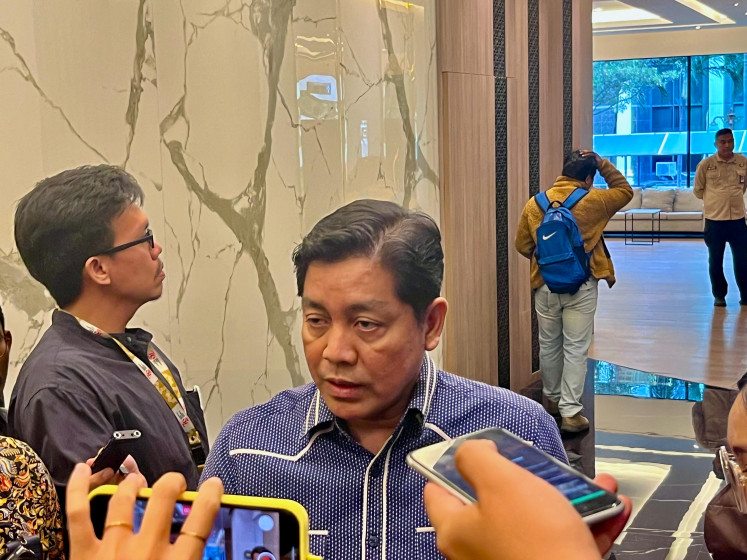Popular Reads
Top Results
Can't find what you're looking for?
View all search resultsPopular Reads
Top Results
Can't find what you're looking for?
View all search resultsTang Dynasty ceramic unearthed at Central Java excavation site
Ancient treasure: Samudi, a worker at an archeological dig site, shows fragments of Tang Dynasty ceramics dating from the 9th to 10th century, at the Liyangan site in Temanggung, Central Jakarta
Change text size
Gift Premium Articles
to Anyone
 Ancient treasure: Samudi, a worker at an archeological dig site, shows fragments of Tang Dynasty ceramics dating from the 9th to 10th century, at the Liyangan site in Temanggung, Central Jakarta. Dozens of Tang Dynasty ceramics were recently found at the site by a team from the Yogyakarta Archeological Agency. (JP/Suherdjoko) (JP/Suherdjoko)
Ancient treasure: Samudi, a worker at an archeological dig site, shows fragments of Tang Dynasty ceramics dating from the 9th to 10th century, at the Liyangan site in Temanggung, Central Jakarta. Dozens of Tang Dynasty ceramics were recently found at the site by a team from the Yogyakarta Archeological Agency. (JP/Suherdjoko) (JP/Suherdjoko)
A
span class="caption" style="width: 598px;">Ancient treasure: Samudi, a worker at an archeological dig site, shows fragments of Tang Dynasty ceramics dating from the 9th to 10th century, at the Liyangan site in Temanggung, Central Jakarta. Dozens of Tang Dynasty ceramics were recently found at the site by a team from the Yogyakarta Archeological Agency. (JP/Suherdjoko)
A team from the Yogyakarta Archeological Center discovered earlier this week hundreds of pieces of earthenware dating back to the Tang Dynasty in China during an excavation at the Liyangan archaeological site in Purbosari village, Temanggung, Central Java.
Found in 2008, Liyangan is believed to have been the site of human habitation during the Mataram era between the seventh and 10th centuries.
'The ceramic is in various shapes and sizes. Most of it has been reconstructed. The number is likely to increase as there are always new discoveries,' the center's team leader, Sugeng Riyanto, told The Jakarta Post recently.
The excavation work will continue until June 28. The archeological team comprises Sugeng, Rita Istari from Yogyakarta Archeological Center, earthenware expert Yusmaini Eriawati and Fadhlan SI, a geologist from the National Archeology Center.
Based on their analysis, most of the ceramic originated from Guangdong, Changsa and Yue in China. Earthenware from Guangdong was mass-produced and is fairly rough in style, while ceramic from Changsa and Yue was finer because it was made under the supervision of the government.
As a result, Changsa and Yue ceramic was more sought-after and was traded overseas.
With the discovery of the quality ceramic from the two regions, experts believe that Liyangan was also inhabited by communities that enjoyed a close relationship with the rulers of the day.
The Liyangan site is thought to date back to the same period as the Dieng, Gedong Songo, Borobudur, Prambanan and Ratu Boko archaeological sites.
Dozens of ceramic items were cleaned at the site during the excavation and then taken to the home of a local resident, Samudi, where dozens of other earthenware pieces from China have been reconstructed and restored. Some of the ceramic was still intact.
Besides the earthenware, various relics have also been found at the site. They include metal weapons, chandeliers, carved wooden bed frames and fabrics. The archaeologists also found ruined pillars of a building, which is believed to have been destroyed by an eruption of Mount Sindoro in the year 971.
'We think this area was once occupied by monks or members of the nobility. A human settlement was located below it. Cosmologically, a Hindu house of worship faced the volcano,' Sugeng said.
He also said he believed they could analyze the remnants of fabric to determine the material used and how it was woven.
'We have already identified the timber, which is of the Cemara Pandak and Puspa varieties, both of which are mountain wood,' he said, adding that the analysis was conducted at a lab situated in the forestry school at Yogyakarta's Gadjah Mada University (UGM).
Geologist Fadhlan said the stone used for the temple walls and floors included andesite and sedimentary rocks. However, the team have discovered another variety, which is believed to be granodiorite.
In 2010, the archeologists also discovered the ruins of a wooden house in Liyangan.
'From that finding, we determined that the house had been built on a rock foundation. It had timber pillars, woven bamboo walls and a thatched roof,' Sugeng said.
The foundations of the temple and six flagstones can now be seen at the site. Four of the stones were placed next to the temple, which sported the Hindu yoni symbol, while the two other bases were essentially boulders to strengthen the building, as they were the bases for two structural pillars.
The Liyangan site was originally found by accident by local residents when they were mining sand. To date, sand mining still goes on near the site.









